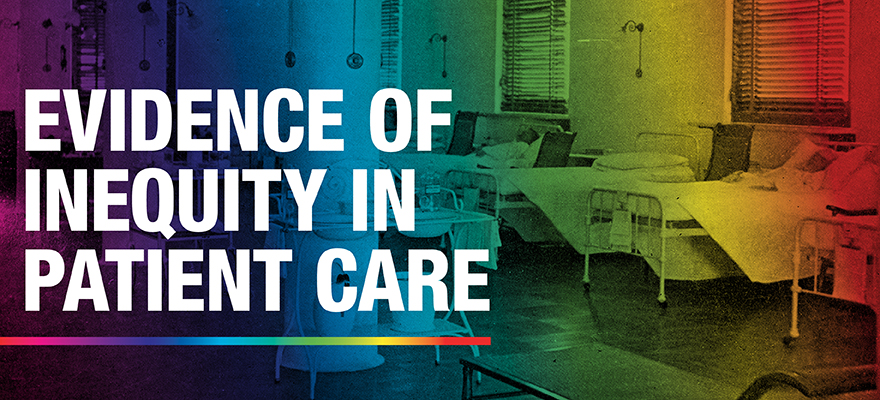Evidence of Inequity in Patient Care
Home
/
About SAEM
/
Academies, Interest Groups, & Affiliates
/
ADIEM
/
Resources
/
DEI Resource Library
/
Evidence of Inequity in Patient Care

ARTICLES
- Journal of the National Medical Association A peer-reviewed publication whose purpose is to address medical care disparities of persons of African Americans and other minority groups
- Myths about physical racial differences were used to justify slavery — and are still believed by doctors today by Linda Villarosa. The excruciatingly painful medical experiments went on until his body was disfigured by a network of scars. John Brown, an enslaved man on a Baldwin County, Ga., plantation in the 1820s and ’30s, was lent to a physician, Dr. Thomas Hamilton, who was obsessed with proving that physiological differences between black and white people existed. Hamilton used Brown to try to determine how deep black skin went, believing it was thicker than white skin.
- “Slave Life in Georgia: A Narrative of the Life, Sufferings, and Escape of John Brown, a Fugitive Slave, Now in England.” by John Brown. My name is John Brown. How I came to take it, I will explain in due time. When in Slavery, I was called Fed. Why I was so named, I cannot tell. I never knew myself by any other name, nor always by that; for it is common for slaves to answer to any name, as it may suit the humor of the master. I do not know how old I am but think I may be any age between thirty-five and forty. I fancy I must be about thirty-seven or eight; as nearly as I can guess. I was raised on Betty Moore's estate, in Southampton County, Virginia, about three miles from Jerusalem Court house and the little Nottoway river.
- Health Disparities in the Latino Population by William A. Vaga, Micheal A. Rodriguez, and Elisabeth Gruskin. In this review, the authors provide an approach to the study of health disparities in the US Latino population and evaluate the evidence, using mortality rates for discrete medical conditions and the total US population as a standard for comparison. They examine the demographic structure of the Latino population and how nativity, age, income, and education are related to observed patterns of health and mortality. A key issue discussed is how to interpret the superior mortality indices of Latino immigrants and the subsequent declining health status of later generations.
BOOKS
- A Book of Medical Discourses: In Two Parts by Dr. Rebecca Lee-Crumpler, first African American woman to earn an M.D. degree
- Medical Apartheid: The Dark History of Medical Experimentation on Black Americans from Colonial Times to the Present by Harriet A. Washington. The product of years of prodigious research into medical journals and experimental reports long undisturbed, Medical Apartheid reveals the hidden underbelly of scientific research and makes possible, for the first time, an understanding of the roots of the African American health deficit. At last, it provides the fullest possible context for comprehending the behavioral fallout that has caused black Americans to view researchers—and indeed the whole medical establishment—with such deep distrust.
- "Slave Life in Georgia: A Narrative of the Life, Sufferings, and Escape of John Brown, a Fugitive Slave, Now in England.” autobiography of John Brown, published in 1855. My name is John Brown. How I came to take it, I will explain in due time. When in Slavery, I was called Fed. Why I was so named, I cannot tell. I never knew myself by any other name, nor always by that; for it is common for slaves to answer to any name, as it may suit the humour of the master. I do not know how old I am but think I may be any age between thirty-five and forty. I fancy I must be about thirty-seven or eight; as nearly as I can guess. I was raised on Betty Moore's estate, in Southampton County, Virginia, about three miles from Jerusalem Court house and the little Nottoway river.
- Unequal Treatment: Confronting Racial and Ethnic Disparities in Health Care: Confronting Racial and Ethnic Disparities in Healthcare by Dr. Mona Hanna-Attisha. In Unequal Treatment, a panel of experts documents this evidence and explores how persons of color experience the health care environment. The book examines how disparities in treatment may arise in health care systems and looks at aspects of the clinical encounter that may contribute to such disparities.
- What the eyes don’t see by Mona Hanna- Attisha. WHAT THE EYES DON’T SEE is a powerful first-hand account of the Flint water crisis, the signature environmental disaster of our time, and a riveting narrative of personal advocacy. Here is the dramatic story of how Dr. Mona used science to prove Flint kids were exposed to lead, and how she courageously went public with her research and faced a brutal backlash. With persistence and single-minded sense of mission, she spoke truth to power. The book explores the horrific reality of how misguided austerity policies and callous bureaucratic indifference placed an entire city at risk.
VIDEOS
- APHA's Advancing Racial Equity series: Racism: The Ultimate Underlying ConditionThis kick-off webinar of APHA's Advancing Racial Equity series examined racism and its historic and present-day impact on health and well-being.
- APA: Racism and Black Mental Health. 1 AMA CME Free. This learning module prepares contemporary psychiatrists to practice with an anti-racism framework in the care of all patients, and especially African Americans. Competency in this area is provided through exploration of historical facts underscoring the linkage of "race" and material disadvantage in America, as well as the spread of scientific racism during nascent periods of psychiatry. Contemporary issues affecting African-American patients at the point of mental health care are emphasized, along with discussion of effective interventions for addressing the institutional, interpersonal, and internal manifestations of racism.
PODCASTS
- “The Health Disparities Podcast” by Movement is LifeTM is a multi-disciplinary coalition. Is a series of conversations about health disparities with people and organizations who are working to eliminate them
- The Praxis This podcast aims to directly address and explore the effects of racism and other forms of marginalization so that we can collectively achieve health justice. We will journey through history, theory, science & medicine by embracing storytelling, interviews, and community expertise.
- 1619, Episode 4: How the Bad Blood Started Black Americans were denied access to doctors and hospitals for decades. From the shadows of this exclusion, they pushed to create the nation’s first federal health care programs.
WEBSITES
- Disparities by Indian Health Service
- Institute for Healthcare Improvement: TA 102 Improving Health Equity , The 1.5-hour CME Course
- Office of Minority Health Knowledge Center host books, journal articles and media related to the health status of racial and ethnic minority populations in the United States.
- Latino Health Disparities by League of United Latin American Citizens (LULAC)
- LGBTQ and Two Spirit people Health Resources by Indian Health Service
- Racial Equity Institute resources to proactively understand and address racism in an organization and in the community where the organization is working
- Brown Skin Matters - database of dermatological conditions on non-white skin for open use
- Black & Brown Skin - Mind the Gap









